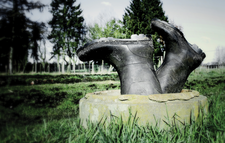Boot Repair Disk
Start Assist

© Lead Image © Spacejunkie, photocase.com
Sometimes things go wrong when you are installing an operating system on a hard disk drive or SSD. A boot repair disk gets your boot configuration back on its feet, quickly.
The boot process for computers has become massively more complicated in recent years. Unified Extensible Firmware Interface (UEFI) has largely replaced the traditional BIOS, while increasingly large storage devices require new types of partitioning.
The configuration options of bootloaders such as GRUB 2 have thus been massively extended; even minor changes to the system can cause start-up problems. In the worst case, you will be left sitting in front of a black screen with a flashing cursor without the operating system having booted.
In this situation Boot Repair Disk provides invaluable assistance: The operating system, based on the lean Lubuntu 14.04 LTS with the LXDE desktop takes care of damaged boot configurations even in heterogeneous environments, repairing them automatically at the push of a button.
[...]
Buy this article as PDF
(incl. VAT)
Buy Linux Magazine
Subscribe to our Linux Newsletters
Find Linux and Open Source Jobs
Subscribe to our ADMIN Newsletters
Support Our Work
Linux Magazine content is made possible with support from readers like you. Please consider contributing when you’ve found an article to be beneficial.

News
-
AerynOS Alpha Release Available
With a choice of several desktop environments, AerynOS 2025.08 is almost ready to be your next operating system.
-
AUR Repository Still Under DDoS Attack
Arch User Repository continues to be under a DDoS attack that has been going on for more than two weeks.
-
RingReaper Malware Poses Danger to Linux Systems
A new kind of malware exploits modern Linux kernels for I/O operations.
-
Happy Birthday, Linux
On August 25, Linux officially turns 34.
-
VirtualBox 7.2 Has Arrived
With early support for Linux kernel 6.17 and other new additions, VirtualBox 7.2 is a must-update for users.
-
Linux Mint 22.2 Beta Available for Testing
Some interesting new additions and improvements are coming to Linux Mint. Check out the Linux Mint 22.2 Beta to give it a test run.
-
Debian 13.0 Officially Released
After two years of development, the latest iteration of Debian is now available with plenty of under-the-hood improvements.
-
Upcoming Changes for MXLinux
MXLinux 25 has plenty in store to please all types of users.
-
A New Linux AI Assistant in Town
Newelle, a Linux AI assistant, works with different LLMs and includes document parsing and profiles.
-
Linux Kernel 6.16 Released with Minor Fixes
The latest Linux kernel doesn't really include any big-ticket features, just a lot of lines of code.

